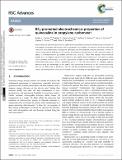BF[subscript 3]-Promoted Electrochemical Properties of Quinoxaline in Propylene Carbonate
Author(s)
Diesendruck, Charles E.; Moore, Jeffrey S.; Curtiss, Larry A.; Assary, Rajeev S.; Carino, Emily; Brushett, Fikile Richard; ... Show more Show less
DownloadCarino-2015-BF3-promoted.pdf (773.7Kb)
PUBLISHER_CC
Publisher with Creative Commons License
Creative Commons Attribution
Terms of use
Metadata
Show full item recordAbstract
Electrochemical and density functional studies demonstrate that coordination of electrolyte constituents to quinoxalines modulates their electrochemical properties. Quinoxalines are shown to be electrochemically inactive in most electrolytes in propylene carbonate, yet the predicted reduction potential is shown to match computational estimates in acetonitrile. We find that in the presence of LiBF[subscript 4] and trace water, an adduct is formed between quinoxaline and the Lewis acid BF[subscript 3], which then displays electrochemical activity at 1–1.5 V higher than prior observations of quinoxaline electrochemistry in non-aqueous media. Direct synthesis and testing of a bis-BF[subscript 3] quinoxaline complex further validates the assignment of the electrochemically active species, presenting up to a ~26-fold improvement in charging capacity, demonstrating the advantages of this adduct over unmodified quinoxaline in LiBF[subscript 4]-based electrolyte. The use of Lewis acids to effectively “turn on” the electrochemical activity of organic molecules may lead to the development of new active material classes for energy storage applications.
Date issued
2015-02Department
Massachusetts Institute of Technology. Department of Chemical EngineeringJournal
RSC Advances
Publisher
Royal Society of Chemistry
Citation
Carino, Emily V., Charles E. Diesendruck, Jeffrey S. Moore, Larry A. Curtiss, Rajeev S. Assary, and Fikile R. Brushett. “BF[subscript 3]-Promoted Electrochemical Properties of Quinoxaline in Propylene Carbonate.” RSC Adv. 5, no. 24 (2015): 18822–18831. © 2015 Royal Society of Chemistry
Version: Final published version
ISSN
2046-2069